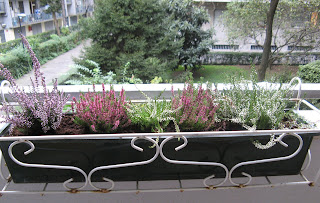Most people reading this will already know May Dreams Gardens. It's a blog which I've read regularly for a couple of years now, and though I don't have time to visit and check out Carol's posts daily, I always try and catch up at the weekend. The posts are funny, down-to-earth and always interesting. So I was thrilled when Carol agreed to do an interview for The Balcony Garden on gardening and blogging.

You live in Indiana. For those of us not in the States, can you tell us a bit about it? Is it a good area for gardening?
Indiana is often called “the crossroads of America” because we are located in the Midwest part of the country, and there are several major highways that go through Indiana. I wrote a post back in February about why I like gardening in Indiana.
When did you start gardening? How quickly did it become a passion?
I’m on one of those gardeners who started at a very young age and can’t remember NOT gardening. It became a passion early on and is one of reasons I decided to major in Horticulture in college.
How is your garden organised?
My vegetable garden takes up about a third of my backyard, the rest is lawn and flower beds. The front is a typical suburban front yard like many found across the United States with a combination of trees, shrubs, and flowers.
Is there anything unusual in your garden which is particularly special for you?
The most unusual plant is probably my night blooming cereus which I inherited from my dad. I’m happy whenever it blooms.
Why did you start blogging? Where did the idea come from?
I read about blogs around 2003 or so and started one in 2004 because I like to write. But I probably posted ten times in those first two years. Then in early 2006, I started posting more often, and here I am!
You post more or less every day, as well as frequently leaving comments on other people’s blogs. And have other blogs too. How much of your time does blogging take up?
I’ll admit I do fall behind on leaving comments on other people’s blogs, and probably have a dozen or so that I comment on the most. But, when it comes to the Garden Bloggers’ Bloom Day posts, I try to comment on anyone’s blog who has left a comment. My other blog, which is about my Grandmother’s diaries, doesn’t take any time at all and I usually set it up about a week ahead so it ‘auto posts’ through the week. The posts on my blog can take as little as 15 minutes or as long as 1 hour to write.
The thing I like best about your blog is that it’s so easy to relate to. Nearly always I find myself thinking “I could have written that – if I’d thought of that angle”. You somehow manage to give a creative twist to the most mundane, everyday gardening topics. How do you get all your ideas?
What a nice compliment! My ideas come from being a gardener myself, I guess. The more time I spend gardening, the more ideas I get. And when an idea comes to me, I’ll try to write down a few notes about it so I don’t forget.
You’ve also started some incredibly successful memes – Gardeners’ Bloom Day for instance, which continues to grow and grow. Why do you think it’s become so popular? Will it go on for ever?
I think Garden Bloggers’ Bloom Day is popular because it gives gardeners a good reason to show off their blooms and at the same time compare to what others have in bloom. I’ve learned so much about other climates that people garden in, and who has what blooming through bloom day. Every month, there are a few garden bloggers who post for the first time, and others who drop out. And many gardeners have noted that after doing it for over a year they now have a journal of sorts of their own garden and can compare this year to last year, which they couldn’t really do before. I’m going to keep doing it and I hope others continue as well.
You’ve been blogging for a relatively long time. How has your blog changed in that time? Where do you see it going in the future?
I hope my writing has improved over time! I’ve recently branched out to writing for Examiner.com as the Indianapolis Gardening Examiner, and have been thinking about other venues for garden writing.
Has blogging and the blogosphere changed since you started? How?
Yes, it has changed. There are more blogs, many good blogs. And many bloggers now use sites like Twitter which helps to further create an online community amongst gardeners, and provides a place to provide little updates on first blooms, vegetable harvests, what we are doing in our gardens, etc.
If like me you gardened on a balcony and had limited space, what would you grow?
I think I would grow trough type gardens with miniature plants. I have one garden space devoted to miniature plants mostly hostas and other shade loving plants. I can spend just a few minutes weeding and deadheading in it and then step back and think, “Well, that’s one flower bed done!”.
What was your most important gardening moment?
There are several. I think it is important to plant trees; they will shape the garden for decades to come and help the environment. Another important moment is committing to organic methods only.
What was your most important blogging moment?
The most important moment was probably not on my blog, but because of my blog, connecting with other gardeners and flying to Austin, Texas for what was hopefully the FIRST garden bloggers spring fling. Probably the most touching moment was when Annie in Austin wrote a song about my garden. . But every day, I’m touched by the comments other gardeners leave on my blog and the connections I make through my blog with other gardeners.
Carol, a big thank you. If you're new to garden blogging and have never come across May Dreams Gardens, check it out now. I promise you won't be disappointed!





























































